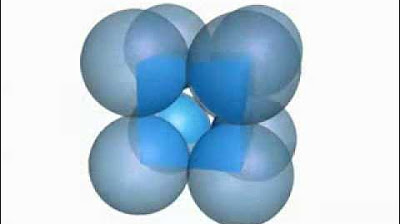Kembar Tapi Beda | Stereokimia 1 | Molekul 3D | Kuliah Online | Kimia Organik
Summary
TLDRThis educational video explains the concept of stereochemistry, focusing on the three-dimensional arrangement of atoms in molecules. It introduces the idea of isomers, specifically stereoisomers, and explains the difference between enantiomers and other isomer types. The video highlights the significance of chiral molecules and their relevance in biological systems, particularly in pharmaceuticals. It uses examples like thalidomide, limonene, and MSG to demonstrate the practical implications of molecular configuration on drug effects and sensory perception. Viewers are encouraged to understand the importance of stereochemistry in molecular biology and medicine.
Takeaways
- 😀 The video discusses the differences between two molecules: levopropoxyphene (used as a cough medicine) and dextrorpropoxyphene (used as a pain reliever), highlighting their structural variations.
- 😀 The concept of stereochemistry is introduced, emphasizing the importance of understanding molecules in three dimensions (left, right, top, bottom, front, and back).
- 😀 Stereoisomers, including enantiomers and diastereomers, are molecules with the same molecular formula but different arrangements of atoms in space.
- 😀 Enantiomers are mirror-image molecules that cannot be superimposed, similar to how left and right hands are distinct but mirror images of each other.
- 😀 A chiral molecule has a stereogenic center, typically a carbon atom attached to four different substituents, making it non-superimposable with its mirror image.
- 😀 A molecule that lacks a stereogenic center is achiral, meaning it can overlap with its mirror image.
- 😀 The importance of chiral molecules is explained, as they often play a significant role in biological processes, interacting with human receptors to produce specific effects.
- 😀 The video explores the controversial history of thalidomide, a drug that caused birth defects due to the presence of an enantiomer that had harmful effects, despite the other enantiomer being safe.
- 😀 Other examples of enantiomers include limonene, where the right-handed (plus) and left-handed (minus) forms smell different, and glutamate, where one enantiomer provides the umami taste.
- 😀 Understanding stereochemistry is crucial in the development of pharmaceuticals and other biologically active compounds, as the correct molecular configuration can have significant effects on their safety and efficacy.
Q & A
What is the main difference between the two molecules discussed in the video?
-The main difference between the two molecules is their usage and chemical structure. The molecule on the left is propoxyphene, used as a cough suppressant, while the molecule on the right is dextrorpropoxyphene, used as a pain reliever.
What does 'stereochemistry' refer to in molecular science?
-Stereochemistry refers to the study of how molecules are arranged in three-dimensional space, particularly how atoms within a molecule are positioned relative to each other.
What are isomers and how are they classified?
-Isomers are molecules with the same molecular formula but different structural arrangements. They are classified into two main types: constitutional isomers, which differ in their atomic connectivity, and stereoisomers, which have the same connectivity but different spatial arrangements.
What is the significance of a molecule's chirality?
-Chirality in molecules refers to their non-superimposable mirror image relationship, meaning that a molecule and its mirror image cannot be aligned perfectly. Chirality is crucial in the biological activity of molecules as their interaction with receptors in the body depends on their specific three-dimensional shape.
What causes a molecule to be chiral or 'giral'?
-A molecule is chiral if it has a stereogenic center, typically a carbon atom that is bonded to four different substituents. If such a center is present, the molecule will have non-superimposable mirror images, known as enantiomers.
What is the difference between a molecule being chiral and achiral?
-A chiral molecule has a non-superimposable mirror image, while an achiral molecule can be superimposed on its mirror image. Achiral molecules either lack stereogenic centers or possess symmetry that allows their mirror images to align perfectly.
What is an enantiomer?
-An enantiomer is a pair of stereoisomers that are non-superimposable mirror images of each other. These molecules have identical physical and chemical properties, except for how they interact with other chiral substances, such as biological receptors.
What are the practical implications of enantiomers in pharmaceuticals?
-Enantiomers can have drastically different effects in the body, even if they are chemically similar. For example, one enantiomer may have a therapeutic effect, while the other could be harmful or cause side effects. This is important in drug design, where one enantiomer may be the active form of a medication.
Why was thalidomide banned in the 1960s?
-Thalidomide was banned because its enantiomer caused birth defects in babies. While one enantiomer acted as a sedative and anti-nausea drug for pregnant women, the other caused teratogenic effects, leading to malformed limbs in newborns.
What is the role of stereochemistry in the biological activity of molecules?
-Stereochemistry plays a vital role in determining how molecules interact with biological receptors. The 3D shape of a molecule affects its ability to fit into and bind with specific receptors, which in turn influences its biological activity and therapeutic effects.
Outlines

This section is available to paid users only. Please upgrade to access this part.
Upgrade NowMindmap

This section is available to paid users only. Please upgrade to access this part.
Upgrade NowKeywords

This section is available to paid users only. Please upgrade to access this part.
Upgrade NowHighlights

This section is available to paid users only. Please upgrade to access this part.
Upgrade NowTranscripts

This section is available to paid users only. Please upgrade to access this part.
Upgrade NowBrowse More Related Video

Chiral examples 1 | Stereochemistry | Organic chemistry | Khan Academy

KEB03 Kristalografi | Materi OSN/KSN Kebumian SMA

Atoms, Elements, and Molecules

The primitive, body-centred and face-centred cubic unit cells

More Stereochemical Relationships: Crash Course Organic Chemistry #9

Stereoisomers: Enantiomers, Diastereomers, and Meso Compounds!
5.0 / 5 (0 votes)